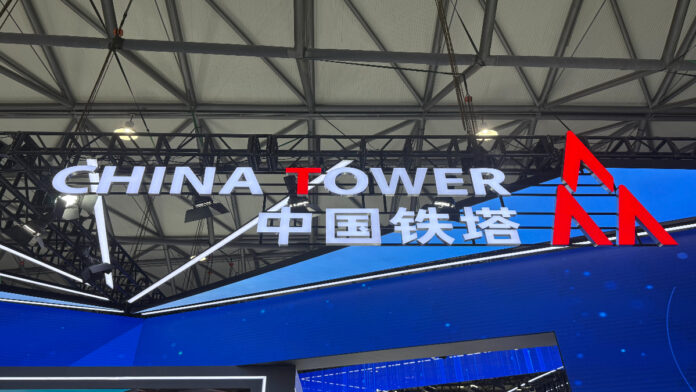China Tower said that total tower tenants rose to 3.84 million at end-June 2025, pushing the average number per tower to 1.81 from 1.80 at the end of June 2024
In sum – what to know:
Smart tower shift accelerates – China Tower ended H1 2025 with 2.12 million towers and 3.84 million tenants, but revenue growth is now led by smart towers, DAS, and energy units.
R&D and AI investment ramp up – The company grew its R&D team by 29% and is focusing on AI, 5G + BeiDou, and edge computing to power digital transformation and sustainable infrastructure.
Clean energy, low-altitude, underground push – New growth areas include solar-powered base stations, drone network support, and underground navigation across 1.5 million sqm in urban environments.
China Tower ended the first half of the year with a total of 2.12 million towers under management, up 2.4% year-on-year, the company said in its earnings statement.
The company said that total tower tenants rose to 3.84 million at end-June 2025, pushing the average number per tower to 1.81 from 1.80 at the end of June 2024.
China Tower’s net profit in H1 2025 surged 8% year-on-year to CNY5.75 billion ($800.3 million), while operating revenue grew 2.8% year-on-year to CNY 49.6 billion.
“Smart tower” revenue amounted to CNY4.72 billion in the period, climbing 18.7% year-on-year, while sales from the company’s energy unit increased 9.2% year-on-year to CNY2.2 billion.
Also, China Tower’s tower business revenue recorded sales of CNY37.8 billion, flat year-on-year, while indoor distributed antenna system (DAS) sales increased by 12% to CNY4.66 billion.
During the period, China Tower said it had accelerated 5G upgrades and continuously optimized active and passive DAS sharing solutions to enhance product competitiveness. “We piloted shared frequency-shifting solutions during the 5G upgrades of existing DAS to ensure that the network quality improves in line with customer requirements,” the company indicated.
“In the first half of the year, we continued to strengthen technological innovation, building robust momentum for sustainable development. We intensified R&D efforts in critical technologies, including next-generation mobile communications, AI, edge computing, 5G + BeiDou integration, 5G shared DAS, new energy solutions, and Internet of Things,” China Tower said.
“In the first half of 2025, our R&D team size increased by 29%, compared to the same period last year, while the cumulative number of patent authorizations rose by 16% since the end of 2024,” China Tower added.
China Tower was formed in 2014, when the country’s mobile carrier China Mobile, China Unicom and China Telecom transferred their telecom towers to the new company. The three telcos decided to create the new entity in a move to reduce redundant construction of telecommunications infrastructure across the country. China Mobile, China Unicom and China Telecom currently own a 38%, 28.1% and 27.9% stake respectively. State-owned asset manager China Reform Holding owns the remaining 6%.
China Tower is reimagining its vast telecom infrastructure into a smart, secure and shared digital backbone to power China’s next stage of digital transformation, Chairman Chi-Yong Chang said during his keynote at MWC Shanghai 2025.
The company’s 5.6 million base stations and 2.1 million tower sites are being made into into intelligent hubs for advanced applications such as edge computing, underground connectivity, AI-powered services and low-altitude drone networks, he said.
“With 900,000 new base stations built per year since 2014, we are enabling one of the highest-quality mobile networks in history,” Chang said. He said shared infrastructure and efficiency-focused design have allowed the company to reduce costs significantly while enhancing both coverage and resilience.
A major pillar of this transformation is the repurposing of towers into multi-use digital infrastructure. China Tower is now enabling a broader ecosystem – from IoT and smart cities to low-altitude aviation – while also supporting satellite internet operators. Notably, 70% of the BeiDou Navigation Satellite System’s ground stations now operate on China Tower’s sites.
Chang also highlighted the company’s clean energy strategy. Base stations are being outfitted with solar panels, battery storage and DC power supply systems, helping reduce emissions and meet zero-carbon goals. Smart energy management systems have been widely deployed to improve efficiency and sustainability.
Beyond ground-level connectivity, China Tower is expanding into digital infrastructure for underground environments. In Xiongnu, the company has rolled out indoor satellite navigation across 1.5 million square meters of underground parking, enabling vehicle guidance and tracking in complex subterranean spaces.

